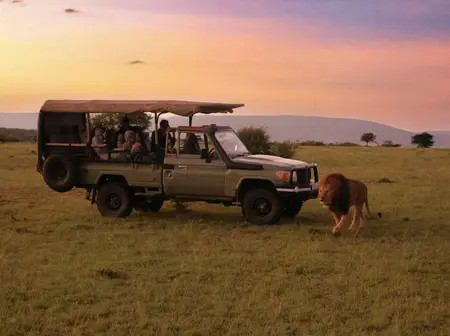Tourism used to be guided by memory, luck, and handshake logistics. If you made it to Nairobi National Park, it was because you knew someone who knew someone who had a cousin with a van. Today, the new gatekeepers aren’t rangers or tour operators — they’re apps.
Kenya’s tourism industry is no longer just modernising. It’s being platformised.
What began as simple digitisation — e-tickets, card payments, online bookings — has evolved into a turf war between global mobility giants and fintech disruptors. Uber and Bolt are no longer competing just for city rides; they’re fighting for control of the safari economy itself. Fintech startups like TouristTap are carving out their own corner, vying to rule how tourists pay, not just how they travel.
The question is no longer how people reach the wild.
It’s who owns the interface to it.
Uber made the first move with Uber Safari, allowing users to summon a game drive vehicle like a standard airport pickup. It was inevitable — once you train consumers to demand rides on tap, excursions start looking like oversized trips.
The company didn’t attempt to reinvent the safari — it simply grafted a familiar interface onto existing tour operator infrastructure. Licensed firms, extended-wheelbase Land Cruisers, vetted guides, regulatory approvals — all held in place beneath a sleek “Book Safari” button.
It was disruption dressed as compliance.
But now Bolt — Uber’s most persistent rival across African cities — is preparing to challenge that position. The company has confirmed plans to enter the Kenyan safari market by late 2025, hinting at pricing that could undercut Uber’s rates. There are no confirmed partner parks, no official vehicle list, and no disclosed safety framework. But one signal is clear:
Uber wants to be the refined gateway. Bolt wants to be the cheap one.
That sets the stage for Kenya’s first true platform battle over wildlife access — and unlike past ride-hailing wars fought on city streets, this one unfolds across conservation land.
Uber’s strategy is intentional restraint. It doesn’t own vehicles or guides but insists its operator partners meet long-standing safari norms: certified drivers, reinforced chassis, formal coordination with Kenya Wildlife Service.
Bolt, by contrast, traditionally grows through rapid onboarding and thinner margins, often tolerating early-phase disorder in pursuit of dominance. If Uber handpicked established safari outfits, Bolt is likely to throw open the gates to smaller, informal operators who’ve historically been excluded from marketing reach.
That could democratise participation — or dilute standards beyond recovery.
Because the Land Cruiser is not an aesthetic choice. It is a survival mechanism. Swap it for a compact SUV to shave off rental costs, and the safari becomes a liability dressed as affordability.
The safari experience has long been a ritual: booked days ahead, preceded by safety briefings, guided by someone who knows which patch of grass hides a leopard. A booking platform flattens that ceremony into interface logic:
Trip accepted. Driver en route. Expected lion sighting ETA — uncertain.
There is cultural cost in that translation. At what point does a lion encounter become just another feature toggle?
Yet it’s equally true that traditional safari systems have been exclusionary. Many Kenyans have never set foot in national parks — not due to disinterest, but because the booking process has historically been opaque, expensive or simply intimidating.
If Bolt pushes pricing lower and access wider, wildlife tourism could finally become routine for local families instead of aspirational. The question is whether affordability is achieved through efficiency — or extraction.
If Uber and Bolt are fighting to move tourists, fintechs are fighting to charge them.
Enter TouristTap — a quiet but explosive idea: turn any smartphone into a POS terminal. No hardware. No bank account. No currency headaches. A Maasai beadwork seller or campsite ranger can now accept Visa, Mastercard, or M-Pesa on the spot.
It is financial inclusion — but also financial annexation.
Visa is already piloting tap-to-pay in Samburu. Local wallets are lobbying to make M-Pesa mandatory at park gates. A splintered future is possible:
Tourism is no longer nature vs infrastructure. It’s software vs sovereignty.
If Uber controls access, and TouristTap controls payment, and Google Maps controls navigation — how much of the safari is still Kenyan?
Platforms are not competing for fleets. They’re competing for default behavior. The first app you use to book a safari becomes the app you use forever. And once they own the first tap, they’ll monetize the rest:
And the moment this becomes normalized, tour operators risk becoming silent subcontractors—visible on the ground, invisible in the transaction.
The industry is moving toward one of two very different outcomes.
Uber and Bolt don’t wait for permission — they become safari gatekeepers by sheer usage. TouristTap and Visa quietly turn into unofficial revenue officers, handling payments before the government even sees them. Regulations stop coming from wildlife authorities and start emerging from backend dashboards.
Kenya builds its own digital framework before the platforms lock in dominance. Instead of negotiating app by app, it creates a national booking and payments API — a system private players must plug into. Surge pricing is capped. Revenue splits are transparent. Local communities are legally wired into every transaction.
That’s the real fork in the road. It’s not about whether technology belongs in conservation. It’s about who dictates the rules it runs on.
Booking a game drive will soon feel no different from ordering lunch. The friction is disappearing fast.
It will feel efficient — until something glitches.
And then the obvious question appears: Who steps in when software gets it wrong?
Because lions don’t pause for system errors — humans do.

Leave a Reply